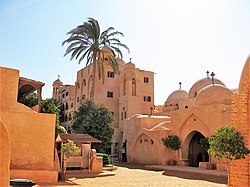Monastery of St. Mary Deipara
 |
|
| Monastery information | |
|---|---|
| Other names | Deir al-Sourian |
| Established | 6th century |
| Dedicated to | Virgin Mary |
| Diocese | Coptic Orthodox Church of Alexandria |
| People | |
| Founder(s) | Syrian Monks |
| Important associated figures |
Pope Gabriel VII Pope Shenouda III Saint John Kame |
| Site | |
| Location | Wadi El Natrun |
| Country |
|
| Coordinates | 30°19′04″N 30°21′15″E / 30.31778°N 30.35417°E |
| Public access | Yes |
The Syrian Monastery, (also known e.g. as Suryan Monastery, Deir el-Surian, Deir el-Syriani, or the monastery / church of Maria Deipara) is a Coptic Orthodox monastery located in Wadi El Natrun (the Nitrian Desert), Beheira Governorate, Egypt. It is located about 500 meters northwest of the Monastery of Saint Pishoy. Ecclesiastically, the monastery is dedicated to the Virgin Mary and carries her name; and in scholarly references from the nineteenth century, it is generally called the covenant/convent/monastery of St. Mary Deipara. However, it is nowadays better known as the Syrian Monastery because it was mainly used by Syriac monks.
The exact date of the monastery's foundation is unknown. Most sources seem however to agree that its foundation took place in the sixth century AD. The establishment of the monastery is closely connected to the Julian heresy, which spread in Egypt during the papacy of Pope Timothy III of Alexandria. The Julianists believed in the incorruptibility of Christ's body. This was in contradiction with the teaching of the Orthodox Church, which held that Christ had taken human flesh that prevented him from being ideal and abstract, and therefore corruptible. Yet, in the monasteries of Scetes, a majority of the monks embraced the Julian heresy. In reaction, those who did not follow the heresy obtained permission from the governor Aristomachus to erect new churches and monasteries, so that they could settle apart from the Julianists. These new facilities were often built alongside the old ones, even keeping the same name but adding to it the word Theotokos, thus recognizing the significance of the incarnation, which the Julians seemed to minimize. The Syrian Monastery was therefore established by those monks of the Monastery of Saint Pishoy who rejected the Julian heresy. At the time of its construction, they called it the Monastery of the Holy Virgin Theotokos.
...
Wikipedia

